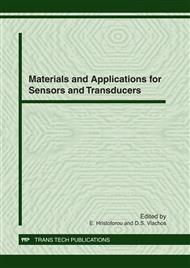p.181
p.190
p.194
p.198
p.201
p.205
p.209
p.213
p.216
Low Frequency Measurements in Amorphous Wire for Studying GMI Effect
Abstract:
When a soft ferromagnetic material is flown by an ac current and a magnetic field is applied at the same time, a major change of its impedance is occurred. The aim of this paper is to investigate the influence of low frequency (1KHz-12KHz) ac current and the applied magnetic field on an amorphous magnetic wire (Co68Fe4.35Si12.5B15) without glass coating. For this purpose an experimental configuration has been setup, based on a Wheatstone bridge which receives an ac input signal from a frequency generator. The output is connected to the amorphous wire wrapped with a coil supplied by a dc voltage for the generation of the magnetic field. The output voltage pulse is measured for two cases a) The value of ac frequency is changing while the value of dc voltage applied to the coil remains constant (the magnetic field remains unchanged) and b) the magnetic field is changing while the ac frequency remains constant to a predefined value. Experimental results of the first scenario showed that when the frequency is altered a non-linear increase of the ac signal is observed at the output which shows an increase of the GMI effect and is related to the non-linearity of the wire’s permeability. For the second scenario the results showed an increase of the output signal offset (voltage) which also indicates an increase of the GMI effect.
Info:
Periodical:
Pages:
201-204
Citation:
Online since:
November 2011
Authors:
Keywords:
Price:
Сopyright:
© 2012 Trans Tech Publications Ltd. All Rights Reserved
Share:
Citation:


